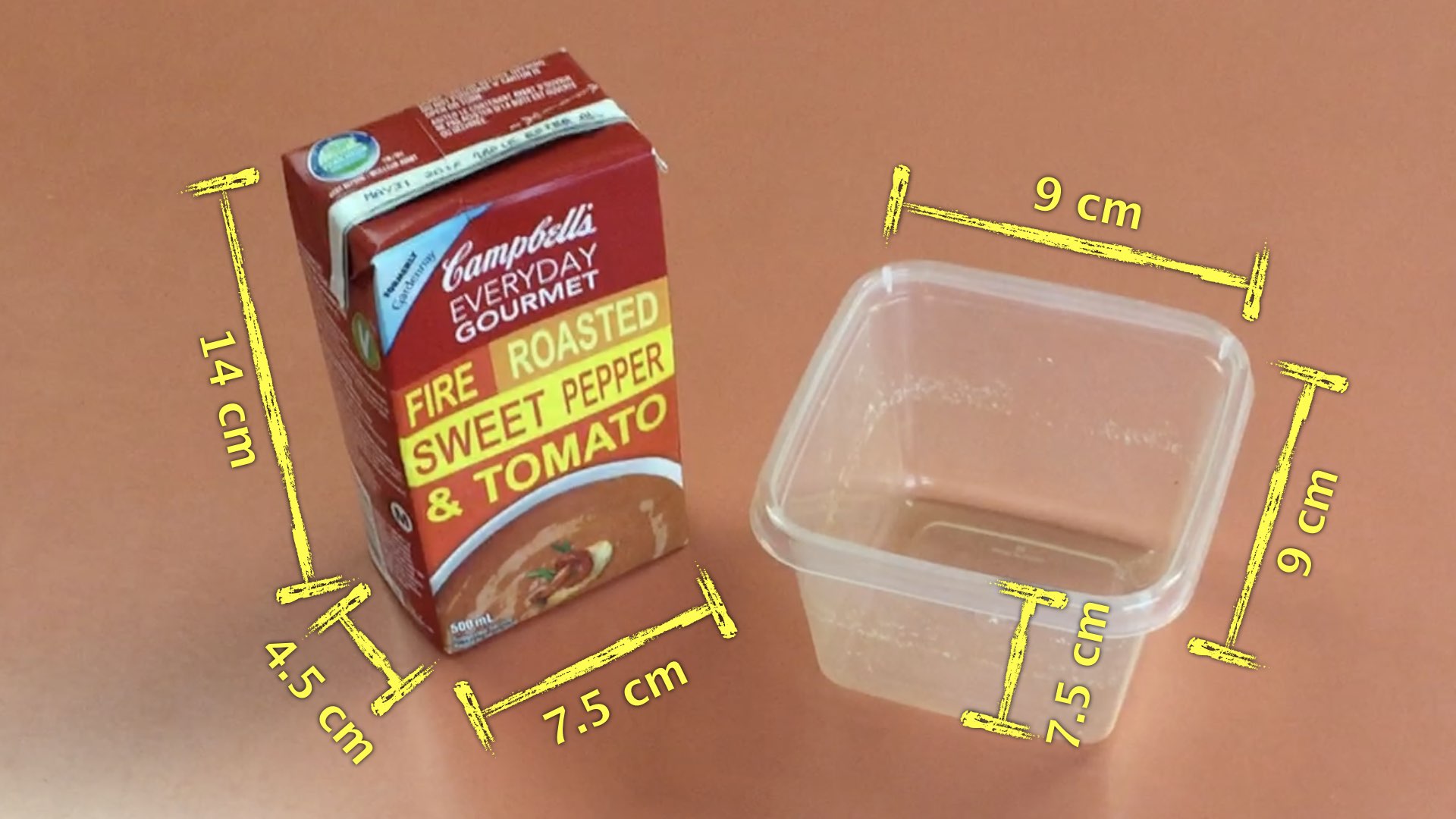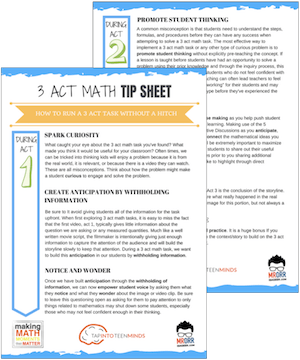Ontario Alignment By Overall Expectation
Will the entire box of soup fit in the container?
In this 3 act math task, we are given a glimpse of a “box” of Campbell’s Soup and we are left wondering if the entire rectangular prism-shaped box will fit in the rectangular-prism shaped Tupperware container.
This task can be modified for use in Grades 1 to Grade 9 where students learn early on about capacity, however they are using non-standard measurements. As we move up through the grades, we begin using standard measurements.
While I will provide enough information for use in an intermediate classroom, please note that we do not want to rush students to formulas too soon. Be sure to reference the curriculum and use your professional judgement to ensure that you are not rushing to the formula before students are ready.
Act 1: Sparking Curiosity
Ask students to create a chart that says “notice” and “wonder” at the top. While they watch the following video clip, have them independently jot down everything they notice and wonder.
Ready? Set. Go!
*In a Grade 1 to 4 classroom, I’d much rather have the actual container of soup and Tupperware container so students can see this happening concretely.
Give your students some time to share out what they noticed and wondered while watching the video with their neighbours. I usually give about 60 seconds for this.
Then, share out to the entire class.
Here are some examples of things they may have noticed or wondered:
- There were two rectangular prisms.
- One was taller and narrow, while the other was more like a cube.
- That’s my favourite kind of soup!
- Is the entire container of soup going to fit in the container?
- Which holds more?
- And many others…
After taking the time to jot down each notice and wonder, as well as respecting each as equally as possible (i.e.: not getting super excited for one and not another), we will try to narrow down to a question such as:
Will the soup fit in the plastic container?
Give students an opportunity to make a prediction by first thinking independently and then having them share their prediction with a neighbour.
You might even have students vote on whether it will overflow, leave some room or fit perfectly.
If I’m in a grade 5 classroom or above, I would have students estimate the dimensions of each container and see if that can help them update their prediction. Sharing out any new information that comes out of that activity would be beneficial for the class as well.
Act 2: Reveal Information to Fuel Sense Making
In a Grade 1-4 classroom, we would actually allow students to do the experiment to let students experience the conservation of volume.
In a grade 5 to 9 classroom, giving the students the opportunity to conduct the experiment would also be ideal, however prior to giving them the opportunity to pour one into the other, we would ask them to tell us what other information they might want to improve their prediction.
Some students might request the dimensions of the containers, which we can provide below:

Fuel Sense Making: Consolidating the Learning
Once students have been given enough information to now make calculations to improve their predictions, we will use the 5 Practices for Orchestrating Productive Mathematics Discussions to Fuel Sense Making and Consolidate the learning. While we should already be anticipating prior to the lesson to prepare ourselves for what we might see during this stage of the lesson, we are now Monitoring, Selecting, Sequencing and finally Connecting student work to the learning goal for the day.
Interested in seeing a full consolidation of this lesson? Let me know in the comments and I’ll put it together!
Act 3: Reveal the Answer
Students will then watch Act 3 in order to determine how close their updated predictions were to what happened in the real world.
How’d It Go?
This is a lesson that is pretty simple to orchestrate and lead in your classroom because it Sparks Curiosity and leaves lots of room for students to discuss and make predictions.
Let me know in the comments how it went in your classroom!
New to Using 3 Act Math Tasks?
Download the 2-page printable 3 Act Math Tip Sheet to ensure that you have the best start to your journey using 3 Act math Tasks to spark curiosity and fuel sense making in your math classroom!

Share With Your Learning Community:

About Kyle Pearce
I’m Kyle Pearce and I am a former high school math teacher. I’m now the K-12 Mathematics Consultant with the Greater Essex County District School Board, where I uncover creative ways to spark curiosity and fuel sense making in mathematics. Read more.
Access Other Real World Math Tasks
Search More 3 Act Math Tasks
Grade 2 [2.B1.1, 2.B1.3, 2.B2.1, 2.B2.2, 2.B2.3, 2.B2.4, Measurement - M1, Number Sense and Numeration - NS1, Number Sense and Numeration - NS2, Number Sense and Numeration - NS3]
Grade 3 [3.B1.5, 3.B2.1, 3.B2.3, 3.B2.7, Measurement - M1, Number Sense and Numeration - NS1, Number Sense and Numeration - NS3]
Grade 4 [4.B2.1, 4.B2.4, 4.E2.5, 4.E2.6, Measurement - M1, Number Sense and Numeration - NS1, Number Sense and Numeration - NS3, Patterning and Algebra - PA2]
Grade 5 [5.B1.7, 5.B2.9, 5.D1.3, 5.D1.6, 5.E2.6, 5.F1.2, 5.F1.5, Measurement - M1, Measurement - M2, Number Sense and Numeration - NS1, Number Sense and Numeration - NS3, Patterning and Algebra - PA2]
Grade 6 [6.B2.12, 6.B2.9, Data Management and Probability - DP3, Measurement - M1, Measurement - M2, Number Sense and Numeration - NS1, Number Sense and Numeration - NS2, Number Sense and Numeration - NS3, Patterning and Algebra - PA1, Patterning and Algebra - PA2]
Grade 7 [7.B1.3, 7.B1.4, 7.B1.7, 7.B2.2, 7.B2.3, 7.C1.1, 7.C1.2, 7.C1.3, 7.C1.4, 7.D1.6, Data Management and Probability - DP3, Geometry and Spatial Sense - GS1, Measurement - M1, Measurement - M2, Number Sense and Numeration - NS1, Number Sense and Numeration - NS2, Number Sense and Numeration - NS3, Patterning and Algebra - PA1, Patterning and Algebra - PA2]
Grade 8 [8.B1.4, 8.B2.5, 8.C1.1, 8.C1.2, 8.C1.3, 8.C1.4, Data Management and Probability - DP1, Data Management and Probability - DP3, Geometry and Spatial Sense - GS2, Measurement - M1, Measurement - M2, Number Sense and Numeration - NS1, Number Sense and Numeration - NS2, Number Sense and Numeration - NS3, Patterning and Algebra - PA1, Patterning and Algebra - PA2]
Grade 9 [9.B3.5, 9.C3.1, 9.C3.2, 9.C3.3]
Kindergarten [k.15.1, k.15.10, k.15.2]
MAP4C [Mathematical Models - MM1, Mathematical Models - MM2, Mathematical Models - MM3]
MAT1LMAT2LMBF3C [Data Management - DM1, Data Management - DM2, Geometry and Trigonometry - GT1, Geometry and Trigonometry - GT2, Mathematical Models - MM1, Mathematical Models - MM2, Mathematical Models - MM3]
MCF3M [Exponential Functions - EF2, Quadratic Functions - QF1, Quadratic Functions - QF2, Quadratic Functions - QF3, Trigonometric Functions - TF1, Trigonometric Functions - TF3]
MCR3U [Characteristics of Functions - CF1, Characteristics of Functions - CF2, Exponential Functions - EF2, Exponential Functions - EF3, Trigonometric Functions - TF3]
MCT4C [Exponential Functions - EF1, Trigonometric Functions - TF3]
MCV4U [Derivatives and Their Applications - DA2]
MDM4U [Counting and Probability - CP2, Organization of Data For Analysis - DA2, Probability Distributions - PD1, Statistical Analysis - SA1, Statistical Analysis - SA2]
MEL4EMFM1P [Linear Relations - LR1, Linear Relations - LR2, Linear Relations - LR3, Linear Relations - LR4, Measurement and Geometry - MG1, Measurement and Geometry - MG2, Measurement and Geometry - MG3, Number Sense and Algebra - NA1, Number Sense and Algebra - NA2]
MFM2P [Measurement and Trigonometry - MT1, Measurement and Trigonometry - MT2, Measurement and Trigonometry - MT3, Modelling Linear Relations - LR1, Modelling Linear Relations - LR2, Modelling Linear Relations - LR3, Quadratic Relations in y = ax^2 + bx + c Form - QR1, Quadratic Relations in y = ax^2 + bx + c Form - QR2, Quadratic Relations in y = ax^2 + bx + c Form - QR3]
MHF4U [Characteristics of Functions - CF3, Exponential and Logarithmic Functions - EL2, Exponential and Logarithmic Functions - EL3]
MPM1D [AG3, Analytic Geometry - AG1, Analytic Geometry - AG2, LR1, LR2, LR3, MG1, MG2, MG3, NA1, Number Sense and Algebra - NA2]
MPM2D [AG1, AG2, AG3, QR2, Quadratic Relations - QR3, Quadratic Relations - QR4, T2, T3]
Functions [F-BF.1, F-BF.3, F-IF.4, F-LE.1, F-LE.2, F-LE.3, F-TF.5]
Geometry [G-C.5, G-C.8, G-C.9, G-GMD.3, G-GMD.4, G-GPE.4, G-GPE.5, G-GPE.7, G-MG.1, G-MG.2, G-SRT.11]
Grade 1 [1.NBT.4, 1.OA.1, 1.OA.6, 1.OA.A.1, 1.OA.B.3, 1.OA.B.4, 1.OA.C.5, 1.OA.C.6]
Grade 2 [2.NBT.5, 2.NBT.B.5, 2.NBT.B.8, 2.NBT.B.9, 2.OA.2, 2.OA.A.1, 2.OA.B.2]
Grade 3 [3.MD.C.5, 3.NBT.2, 3.NF.1, 3.NF.2, 3.NF.3, 3.NF.A.1, 3.OA.1, 3.OA.5, 3.OA.9]
Grade 4 [4-MD.3, 4.MD.1, 4.MD.2, 4.NBT.6, 4.NF.3, 4.NF.5, 4.NF.6, 4.OA.1, 4.OA.5]
Grade 5 [5.B1.7, 5.D1.3, 5.D1.6, 5.MD.1, 5.MD.3, 5.MD.4, 5.MD.5, 5.NBT.2, 5.NBT.3, 5.NBT.6, 5.NBT.7, 5.NF.1, 5.NF.2, 5.NF.3, 5.NF.4, 5.NF.5, 5.OA.1, 5.OA.2, 5.OA.3]
Grade 6 [6.EE.1, 6.EE.2, 6.EE.5, 6.EE.6, 6.EE.7, 6.G.1, 6.G.2, 6.NS.1, 6.NS.3, 6.NS.6, 6.NS.B.3, 6.NS.C.6, 6.NS.C.7, 6.NS.C.8, 6.RP.1, 6.RP.2, 6.RP.3, 6.RP.A.1, 6.RP.A.2, 6.RP.A.3, 6.RP.A.3.C]
Grade 7 [7.EE.3, 7.EE.4, 7.EE.A.1, 7.G.3, 7.G.4, 7.G.6, 7.NS.A.1, 7.NS.A.2, 7.RP.1, 7.RP.3, 7.RP.A.2.B, 7.RP.A.3, 7.SP.2, 7.SP.5, 7.SP.6]
Grade 8 [8.EE.1, 8.EE.5, 8.EE.6, 8.EE.7, 8.EE.8, 8.F.2, 8.F.3, 8.F.4, 8.F.5, 8.G.5, 8.G.6, 8.G.7, 8.G.9, 8.SP.1]
Grade 9Kindergarten [K.CC.A.1, K.NBT.A.1, K.OA.A.1, K.OA.A.2, K.OA.A.3]
Practice [MP.1, MP.2, MP.3, MP.4, MP.6, MP.7]
Statistics & Probability [S-ID.6, S-MD.4]

Would love to see the full lesson! Going to try something like this today!
Hi Sam! Thanks for stopping by! What else are you looking for? Maybe I have it and just haven’t posted it up yet…
This looks great! I have my TPA next week and need a capacity lesson so would love to do something like this. Grade 2/3. Would you recommend this as a beginning, middle or end of unit task? Did you ever put the full consolidation mentioned in the lesson together? Thanks!
Hi Mary! Feel free to give it a spin! I’m not sure if I can answer the “beginning, middle, end” question as I think it really depends on your group. I personally tend to use 3 act math tasks to introduce ideas, but I need to ensure that they have some sort of entry point. What information can I give them where they can use their prior knowledge to come up with an answer that is helpful (but maybe not precise). Then, during consolidation, we can start to unpack the new learning (depending on your learning goal). Hope this helps!
I would love to see your notes on some examples for consolidating this lesson. I Would be interested in using this to help my grade 6 students understand the concept and hope to calculate the volume of a prism.
I was wondering how we can discuss that this shows volume, I am a student teacher and new to teaching math. I just want to make sure I am prepared for my lesson. As well is there any way we could fit in the relationship between capacity and volume?
Hi Jesse! Great question and I think it all comes back to what your specific learning goal is for this lesson. In the past, I’ve used this task as a great way to begin a discussion around volume and in particular, how much “space” the interior of this container can hold and in this case, how much liquid. When we open the door to capacity, then you might be having a discussion about other kinds of substances including solids, liquids, and gasses. So I suppose the real question is what you are hoping to do with the task and then back planning to what questions you’d want to ask through this task.
Do you think it would be a useful fuel sense making part to show the volume in millilitres of both containers for the younger grades instead of the dimensions? Then it would be an additive thinking problem. For older elementary, it would be great if a students recognized that the 7.5 dimension is the same in both containers and since 9 x9 is 81 and 14 x 4.5 is less than 70, they have all they need to determine the fit.
I would also like to see the consolidate notes of the lesson
Can you provide consolidation notes?
Hi Kyle! I am huge Kyle and Jon fans. You know how to make math accessible to students as well as a teacher like me that is thirsting for underlying deep understanding and multiple ways to help students access the content.